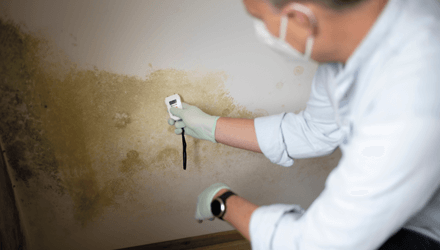By Sophie Neaves on Fri 10 March 2023 in Blog
What are the government requirements for residential ventilation?

Ventilation is a necessity in any home. Without it, houses will become damp, unhealthy places and can even become structurally unsound. To avoid such scenarios, there are now all kinds of ventilation systems available. Some of them even use industrial-grade technology to constantly refresh the air in a room or a whole house.
But what are the requirements regarding residential ventilation? Here we detail what the government stipulates as a minimum for domestic ventilation, including the Building Regulations 2010.
What is household ventilation for?
The concept of house ventilation goes back centuries – because the need for it has been clear for so long. Domestic ventilation serves several purposes, but the most serious relate to keeping occupants healthy.
Reducing condensation and mould growth
There are two obvious sources of moisture in any home: the bathroom and the kitchen. When excess moisture in the air comes into contact with a cold surface, the water vapour transforms into a liquid. This process is condensation. If this condensation occurs repeatedly, it can lead to the growth of dampness and mould.
To avoid this, you need ventilation to remove moisture from household air. Ventilation with temperature control will also deny condensation the cold surfaces it needs to form. Mechanical ventilation with heat recovery (MVHR) performs both of these roles, taking moisture away and maintaining a consistent temperature. As a ventilation system for house usage, MVHR is comprehensive.
All told, you greatly reduce the chances of condensation and mould occurring by introducing proper ventilation. This is important because as well as causing damage to homes and furniture, mould can also have lasting impacts on health.
Protecting health
Over time, mould can cause severe respiratory issues, including chronic obstructive pulmonary disease (COPD), bronchitis and asthma.
Even when mould isn’t present, the indoor air quality (IAQ) might still be poor. As well as respiratory problems, substandard IAQ can lead to cardiovascular disease, neurological conditions or cancer. This is because certain pollutants can build up indoors, unless ventilation is used to remove them.
So the health benefits of refreshing the air supply to homes are many. But is ventilation a legal requirement?
Yes, proper ventilation in house planning is more than good design: the need for ventilation is enshrined in law and the government’s latest building regulations paid special attention to it.
What do the building regulations require for residential ventilation?
Part F of the latest building regulations dictates that all buildings in England should protect the health of occupants by providing adequate ventilation. There are several stipulations that come as part of this.
Extract ventilation
Air should be extracted outside from kitchens, bathrooms, utility rooms and toilet rooms. The method of extract ventilation can be either continuous or intermittent, with different minimum ventilation rates specified for the two methods and the different rooms where they work.
Intermittent extraction
Kitchen (with cooker hood extraction to outside) 30 litres per second
Kitchen (with no cooker hood extraction to outside) 60 l/s
Utility room 30 l/s
Bathroom 15 l/s
Toilet room 6 l/s
Continuous extraction
Kitchen 13 litres per second
Utility room 8 l/s
Bathroom 8 l/s
Toilet room 6 l/s
Whole dwelling ventilation
How much ventilation does a house need? The new regulations set out minimum whole dwelling ventilation rates for air supply to habitable rooms.
Per square metre of floor space, the minimum figure is 0.3 litres per second. But the rate also depends upon the number of bedrooms:
Continuous supply fans or background ventilators should be used to provide this ventilation.
Purge ventilation
Occasionally, the occupants of a home will need a way to quickly remove fumes or air pollutants (such as those from burnt toast, for instance) from the house. This is called purge ventilation. The building regulations ventilation requirements stipulate that each habitable room should have a system in place for it, although that ‘system’ might simply be a door or window. Alternatively, in rooms without such openings, a mechanical extract ventilation system can be used.
Whatever the method in place, the purge ventilation system should be able to change the air in a room at least four times an hour, extracting it directly outside.
Ventilation systems should be designed to minimise the intake of external air pollutants
In our busy cities, being close to sources of pollution is sometimes unavoidable. When residences are located close to road traffic, sources of combustion, industrial sites, construction sites and other significant sources of air pollution, the regulations set out certain rules.
For example, if a home’s air intakes are close to considerable road traffic, the intake vents should be placed as high up as possible, on the less polluted side of the building. Care should also be taken to avoid taking air in from enclosed spaces (like courtyards) where pollutants are discharged by other buildings.
Ventilation systems should be designed to minimise noise
As well as setting out requirements for the fundamental functioning of ventilation systems, ventilation building regulations also detail the need for systems to cause minimal noise.
For mechanical ventilation, it’s important to have ducts of the right size, joined correctly, thereby reducing airflow noise. The size of mechanical systems themselves should also be carefully chosen, so that fans operating in normal background ventilation mode are not overly noisy.
For purge ventilation, meanwhile, consideration should be given to the level of noise outside.
Ventilation systems must be inspected and tested
For mechanical ventilation systems, the building control body must be provided with a commissioning notice and a record of the measured airflow rates.
Meanwhile, checks should be undertaken for background ventilators and intermittent extract fans to ensure that they were installed correctly and work as they should.
In summary
There has been much talk about changes to Part F of the building regulations 2010. The changes introduced more stringent rules around ventilation, covering extract ventilation, purge ventilation, the overall level of ventilation a house needs and more. It all aims to meet the government’s requirements for all houses to protect occupants’ health by supplying sufficient ventilation.


